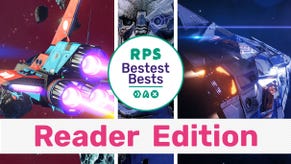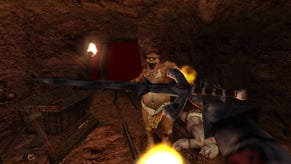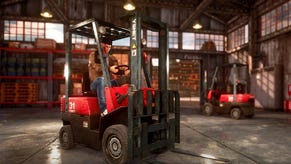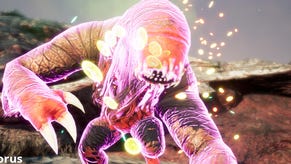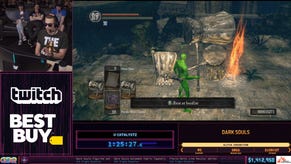State of the Art: The monsters of Prey
A dark bestiary
I'm only a little way into Prey [official site] at the moment but one of the most interesting aspects for me is the monster design. I love pausing the trailers to peer more closely at their glitchy, weird forms without worrying about being killed. The monsters in question are these hostile lifeforms which all come under the bracket of "Typhon" but there are different species of Typhon within that.
The differing shapes, sizes and movements make it easy to distinguish one species from another. There are the scuttling spidery, crabby Mimics, the tentacled, floating Telepaths, the humanoid Phantoms... But there's a common visual thread - all of them are these glitchy, threatening oilslicks whose forms never quite settle. Even when dead their surfaces ripple and shimmer. Emmanuel Petit (lead visual designer) and Jason Timmons (lead visual effects artist) offered their expertise so we could unpack the design of these writhing oddities. Read on to find out why the idea of colour palettes makes the team laugh and how they repurposed foliage tools for monster silhouettes!
You can see larger versions of the images by clicking on them and as an FYI I've reworded some of the questions for clarity as it was an email-based Q&A! There are also some potential spoilers as part of this so read with caution if you haven't finished the game...
Pip: The exploration and research drawings Emmanuel and Jason sent over are threaded throughout the piece but we started out with them explaining how the brief guided them towards these shifting creatures:
Emmanuel Petit: Here are some explorations and researches that helped driving the aliens look. Raphael and Ricardo (Creative Director and Lead Designer) wanted to tell a different story than “gross lizardmen invading earth” so we went for a more paranormal or supernatural approach. I think the key with the Typhon is more about how they feel rather than really how they look, which relied heavily on their behaviours and not so much on their actual design.
Jason Timmons: Yes, as Emmanuel said, Raf and Ricardo wanted to avoid the cliché, and really started the conversation by explaining how these aliens were different, how they made you feel by observing their behavior in a relatable environment, such as a space station. What we came away with was that these aliens needed to be visually undefined, mysterious, blurry, and like Emmanuel said, paranormal in nature even. I was excited that we were not going to do the typical big muscles and pointy teeth aliens you always see everywhere. So with this information in mind, we started to do a lot of previsualization and pretty quickly found something that got people excited.
Pip: I'm interested to get an idea of your thinking as they took shape (pun not intended for the mimics!) – what were your influences, technical developments/limitations/colour palettes and so on?
Jason: Hah, colour palettes! I laugh because black was what we had to work with! From the very beginning, Raf’s vision for the aliens was for them to be black and mysterious. So we’re like "Ok, black aliens, in space, in the dark... how the hell!” But honestly we all embraced the challenge.
Emmanuel: The development of those creatures has been really atypical and challenging as those designs were in constant evolution. We usually started with a broad idea of what we wanted a creature to look like and kind of enhanced it as we went using what Cryengine could offer, such as a vertex animation shader that helped us make their shape always shift a little.
As far as visuals there was very little that we could act on; given that those are black and blurry, all of the visual complexity has to be indicated in the silhouette. A good reference as far as I'm concerned is time-lapse photography of people, especially dancers in motion, and in particular the Metamorphosis series by Frederic Fontenoy [the images via that link are NSFW given they involve nudity, even though it's heavily distorted for the most part].
Pip: One of the defining features of the Typhon is them never quite settling on a fixed form – they have smoky effects, screen glitches, electrical sparks, they grow tendrils, or turn into other objects and even when you've destroyed them the remaining bits of their bodies have skin that seems to ripple and change. I'd like to know more about the challenges in creating those effects.
Emmanuel: All the effects are meant to support the global Typhon design as something, to quote Raphael “that does weird shit”. The monster models are really simple as by design they cannot be too descriptive, so we looked for other ways to make them look more interesting, by adding particles and a blurry animated shader.
The vertex deformation shader is actually something included in Cryengine, which is originally meant to animate the foliage! First time we used it for something else than the vegetation foliage was for the Coral, then we carried that feature over to the rest of the Typhon line up. It was a simple way to add something interesting to those creatures. Beyond that, a radical way to make them more visually interesting is to give them a way to impact their surroundings.
Jason: Right, giving these creatures the ability to impact their surroundings was a way for us to make them feel more real and more grounded. They are as much a part of Talos I as the station is itself. These things have become embedded within the station. The Typhon blend in with the environment, cause electrical systems to go haywire, and as you yourself take on alien powers, the station also begins to turn against you as if fighting back a virus. I’m not sure if Raf and Ricardo always intended this to be this way from the beginning, but it sure seems like it was meant to be!
As for the challenges involved in creating their effects, I’d say the biggest was getting them to look the way we wanted and perform efficiently on the hardware at the same time. Originally we tried to solve the visual look of the Typhon using a custom material shader. Working with Senior Graphics Engineer, Will Reynard, we achieved many promising results, but in the end, in order to allow as many creatures on screen as possible at one time, we needed to move towards a cheaper, more traditional rendering method.
Whereas the initial shader attempts relied heavily on transparency and post-process, the character team was able to find a clever way to use simple 1-bit alpha textures (as opposed to more expensive 8-bit alpha) to create the transparency in the Typhon we craved. UV scrolling plus the vertex deformation Emmanuel mentioned gives us the pulsing material movement we wanted, which gives the Typhon's body the feeling that its life blood is pumping through its skin.
Lastly, and one of the most important things in creating the proper Typhon feel, was to make sure that we stuck to the initial concept of them being mysterious and undefined. We wanted them to appear blurry, and the graphics team came up with the brilliant idea to solve the blurring of the aliens by taking advantage of the engine's built in motion blur to trick the renderer into thinking the alien mesh was constantly shaking, thus motion blurring it even while it appears to not be moving. The Typhon got this for free since the engine was already paying for this cost. Win-win!
Pip: So are they more intensive on players' machines? And do these techniques affect how Typhon interact with the environment if some elements aren't supposed to be solid?
Emmanuel: The idea is that they're a part of a bigger whole we refer to as the simulation. If the player wants to try something, from kicking furniture around or opening doors with a nerf gun, we try to accommodate it as we think interactions in general are rewarding, and we like to encourage it. Same goes for the creatures. They push things around, disrupt the electronics, etc. Of course this whole simulation has a solid cost, it needs a lot of physic and generally reactive objects that don't come cheap in terms of performances.
Jason: Not any more intensive than your typical video game AI. It’s all a balancing act. The system has a finite amount of processing power, and it’s up to the developers to decide how we allocate it.
As I mentioned above, we could have gone for a more complex shader solution, but it would come at the cost of some other elements in the game, perhaps less dynamic lights in a level or maybe not as many physical objects in the world. In the end we made the decisions we made to balance things as best we could for the good of Prey.
Pip: How did you get the mimic's tentacles to look right?
Jason: Getting the tentacles to look right was thanks to so many people on the dev team... from the clever tech artists, who made some pretty fantastic rigs for our Typhon, enabling them to stretch and bend in untraditional ways, which in turn, provided our talented animators the tools they needed to make unique and exciting Typhon behaviours, and finally the AI team putting it all together to make the final behaviors that we see in game today.
Pip: Were there any other elements you needed to keep consistent across the types of Typhon or did having such a distinctive substance mean you could vary them far more without losing the sense that they relate to one another?
Emmanuel: The tentacles are also a recurring feature of the Typhon, but as far as variety we were limited to their silhouettes, which is not a lot when you're trying to avoid them reminding you too strongly of anything that exists.
Jason: They only needed to share the same material visual context, since they all are a part of the same alien ecology. Beyond that and tentacles, we were free to embrace the idea that each Typhon organism is unique in its own way, fulfilling its purpose within the game world. We were able to rely on their different movements and behaviours, how they affected their environment, such as the Phantoms' ability to cause electrical devices within its radius to become disrupted, and finally, the most exciting for me, was each creature's unique set of powers represented by some incredible VFX!
Pip: I believe Dishonored's art director, Sébastien Mitton, worked with the team a little, helping set up an Arkane-type art culture. Was there much cross-pollination between the teams aside from that? I'm interested in whether there was any sharing of assets or ideas between things like the way the creatures work and, perhaps Emily's Far Reach ability from Dishonored 2?
Emmanuel: Sebastien followed up on the project as much as his schedule allowed – he helped with defining the Neo-deco setting, he provided us with a bunch of very important references, showed some of their progress on Dishonored to us when he was visiting here... We also benefited from various Lyon's artist help for concepts, characters, UI and environment at different stages of the production, as well as occasional feedback. So it's not only a culture thing, it was also concrete help!
Jason: It’s great that you bring up the Emily’s far reach ability being that the visual effects are very similar. Honestly, the two had no relation to each other at all, it was purely coincidental! I remember consulting the Lyon Effects Team to pick their collective brain on how they were going about implementing the effects from a technical standpoint, because they really nailed it!
Pip: How did you know when you had got the look of the creatures right?
Emmanuel: I don't think we could boil it down to one moment – there were ideas that emerged here and there throughout development that we retained because they conveyed the right idea. To me they started looking right when we started giving them a more shredded look, almost like wraiths, after going back and forth with the character artist.
Jason: I’d have to agree with Emmanuel, it was a steady progression throughout production. However, there was one huge hurdle we overcame very late in development. We battled for a while with the 'aliens are too dark' problem, but in the end we were able to once again take advantage of something the engine was already paying for... cubemaps!
They are textures that represent the reflections of the environment onto an object, and we made a special one that only the aliens receive at all times, so even in a dark environment, they look like they are reflecting light, thus solving the problem once and for all! For me at least, once we achieved this we knew we had it right!
Pip: At various points you see the glowing golden filaments left by the weavers as coral and I've noticed you get a similar tiny version of that effect if you hit a screen with a wrench. I'm only part way through the game so I don't know if this turns out to be Really Significant but I'm interested in effects recurring in different contexts. Was this a choice to make the coral seem more at home in the world by having these little echoes?
Jason: Spoiler Alert!! The particular example you refer to I’m afraid is not related to the coral unfortunately. What you are seeing when you hit the screen is the ‘Healing Glass’ effect, and is just a coincidence that they resemble each other. The healing glass was a way for us to solve unbreakable glass in a cool way, by chalking it up to the game’s fiction!
We didn’t want players to question why some glass breaks and some doesn’t. We needed the interactive screens to be unbreakable, and certain areas be inaccessible, so we came up with the Healing Glass technology. What you see when you hit a screen is the effect of the glass ‘repairing’ itself.
However, this doesn’t mean that we didn’t have little echoes throughout the game! Many of the technologies throughout Prey are a direct result of the Alien’s ecology, either directly derived from Typhon abilities themselves as with Morgan’s powers, or with the various technological inventions, devices and weapons that are of use throughout Prey.
Another Spoiler Alert! The coral itself is in essence, its own little echo...
Pip: The shapes of the creatures were interesting – the mimics seem to be about channelling the movement and form of things like spiders, squid and crabs which I know a couple of my colleagues find unsettling. I'd be interested to hear about any specific research that looked at how animals move if you did that?
Emmanuel: We owe the incredible animations of the Typhon to the talent and hardwork of our animation team lead by Etienne Aubert. It's true that most of the creatures personality is conveyed by their animations and behavior, and at the very beginning animal and insect were a reference, but they went beyond that. Another example is the Nightmare. When we started working on it we were looking at how a praying mantis moved and tried to emulate that same kind of creepy behavior.
Jason: Yes! And I’d also like to add that for the mimics and tentacle motion in general we studied the movements of octopus and squid. The intent for the mimics was to indeed be creepy as well but not to just look like the typical spider, it needed to have its own identity and motion unique to itself. So I’d say it was a combination of things.
Pip: As a last question, it's a bit off topic but I was really taken by surprise when I used the wrench on the aquarium in the hallway near the start of the game. (For readers who haven't played or didn't do this in their playthrough, it turned out to be a screen which was still giving a 3D effect of an aquarium via the remaining fragments – a micro version of what happens when you smash the sliding door) Is there anything you can tell me about how that effect works or the design of the fish tank? It was such a delightful and effective element, both before I broke it and afterwards!
Emmanuel: The fish tank works like all other Looking Glass occurrences found throughout the game. It's a 3D scene that is built inside the level, just like the rest of the rooms, but it's displayed exclusively on the glass surface, like a portal in other games. That technology is vital for the story and was subject to many iterations and optimizations, especially to make the glass look correct when you break it.
Here are some pictures related to the Looking Glass technology. As far as I know the aquarium idea comes from that paint-over by Fred Augis:
And you’ll also find a concept by Dmitry Sorokin that finely depicts how Looking Glass is built:
Jason: I don’t know exactly how it came about but everything in that apartment was meant to reinforce the idea of how deep and involved of a simulation this all was, that even a simple fish tank wasn’t real! We had the Looking Glass tech, and it all just seemed like a no brainer, it was the perfect use of a technology like that! Perhaps we are not too far from this being an actual reality in the not to distance future. Virtual fish tanks! We shall see.
Pip: Thank you both for your time!















